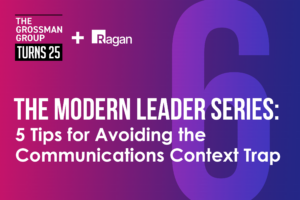How PR should vie for the prestige of the CMO
By proving value and learning the business strategy believed to be the domain of the chief marketing officer, PR execs can be powerful leaders for the organization.

Are PR professionals respected and valued enough within high-tech corporations?
Over the past several weeks I have been clicking on website tabs and reading the list of bios of leadership teams of dozens of high-tech companies. Those pages feature photos of the usual suspects: chief executive officers, chief financial officers, and chief technology officers.
Then you see a photo of someone who holds the title of chief marketing officer, but I haven’t seen any vice presidents of public relations or media relations or chief public relations officers in these sets of pictures.
Why?
Perceived CMO value
The conclusion seems apparent: Companies believe CMOs are more deserving of being on these elite lists of corporate executives.
Anyone who does public relations or media relations, even if worthy of a vice president title, doesn’t rise to that level of seniority and influence in the corporate hierarchy.
Why? Because they don’t deliver as much value as CMOs?
This appears to be the case.
Maybe this is fine and just a detail. But it should be concerning to PR execs wanting more clout within companies and more sway over strategies.
PR execs should be concerned
Should public relations executives be concerned they are not listed among the corporate leadership team as CMOs are?
I believe so. Whatever a CMO brings to the company obviously is viewed as more valuable than what public relations professionals do.
So what should be done about it?
1. Figure out how to add more value to the business leaders.
PR pros need to figure out how they can add more value to the corporate leadership team.
One way to do that is to add more strategic business insight on how public relations directly impacts sales generation and brand enhancement.
2. Tie PR to sales generation.
The closer PR execs tie what they do to how the business increases revenues, the better chance they will have of gaining more respect and being more valued by the senior leadership team.
I believe CEOs of corporations perceive CMOs to have more strategic business insight and business growth skill than public relations pros and are therefore viewed as more valuable to the company. Because of this they often are the top communications pros in the company. Public relations professionals report to them.
PR pros, even at the vice president levels, are not calling the major shots when it comes to corporate communications. CMOs own that role.
3. Become experts at marketing strategy and marketing communications.
Marketing and public relations skills are related, but not exactly the same. A big responsibility of CMOs is helping drive corporate sales. The better they do this, the more they please the CEO and other top leaders.
A PR executive is responsible for external and internal communications and often that means generating press coverage for the company and developing closer relationships with reporters and editors.
The goal is to land positive press coverage. Internally, the mission is communicating effectively to employees about the company’s strategy, mission, changes in direction and new development. The problem is that landing press clippings usually does not directly relate to generating sales through marketing initiatives. To get more top-level respect, a PR exec needs a better grasp on marketing fundamentals.
4. PR pros need to learn content marketing.
Content marketing is increasingly the heart of a corporate marketing programs.
PR pros need to understand content marketing strategies, how to write blogs, white papers, and case studies, how to do competitive content analysis, and how to generate sales leads based on content, such as blogs.
PR and content marketing should no longer be siloed organizations with different agendas; they need to be understood by PR pros and leveraged as a powerful combination of communications vehicles.
By combining these skills, PR pros will become more esteemed among the company’s leaders and enable them to make better PR decisions that help drive sales leads and grow the business in addition to generating sales leads.
5. Develop relationships with top corporate executives.
PR execs need to figure out a way to be invited to the most important top-level corporate meetings. As the situation now stands, CMOs usually have a seat at that table and PR executives don’t.
PR execs need to set up more one-on-one meetings with top corporate leaders and share with them strategic ideas not only for generating press coverage, but generating sales leads and creating real differentiation for the company’s products and services.
Influence = respect
This is all about showing PR pros delivering value to the company—not with a slaws pitch, bu with hard proof. This can be achieved by doing the research, preparing for discussions, understanding how marketing and public relations can be leveraged for a powerful and tightly integrated double play.
With more influence will come more respect. And with more respect will come more responsibilities, more interactions with top leaders, and more fulfilling careers.
Charles Hartley is the president of Carolina Content & Media Relations based in Davidson, NC. The company improves the quality of content marketing, media relations, and writing and editing for high-tech and sports businesses. He can be reached at Charles.hartley@carolina-content.com.







The CMO has loftier title than the DPR and makes a lot more money for three reasons.
.1. Marketing results are easier to measure. Sales and market share are verifiable hard numbers but assessment of goodwill and public attitudes are more of a guess.
.2. Marketing has a much bigger budget so marketing has a bigger say in corporate management. Instead of “put your money where your mouth is,” corporate wisdom is to “put your mouth where your money is.”
.3. Marketing is way more important than PR. It’s like cardiologists earning a lot more than beauticians. But isn’t PR a lot more than beauty? Yes a lot more but cardiology is a lot more than that.
What can you do to get a Sr. VP title and money?
.l. Get into the lobbying end of PR. When you memo top management about big bills that can mean tons of money, you get tons of attention and if successful you get tons of well-deserved respect. Some companies have lobbying report to the general counsel but elsewhere the lobbying chief may be a Sr. VP, sometimes even better.
.2. Get management to retain a great PR firm. If a $1,000+ an hour consultant counsels that you should have a better title and money, you may soon have both. (That’s only part one. Part two is that when someone in management thinks of a different PR firm or a reduced budget, you should be ready with not just arguments but reasons why not.)
.3. Get into marketing. It’s an honorable calling and the money can be honorific!
Agree with Ronald, especially on point #3. Marketing is a much larger umbrella than PR that has much greater impact across the organization – identifying customer needs, analyzing the competitive landscape, guiding product development, establishing pricing strategies, developing brand identity and expression…. and activating that brand through marketing, advertising and PR channels. Since PR is a function that supports just one of the many areas of responsibility of the marketing function, it makes sense that PR reports up into the CMO. I do think many PR people have the skills to expand their career into other areas of marketing, if they choose. Branding, content marketing, social media marketing, digital advertising are all very achievable jumps with professional development and mentorship. And all very interesting and impactful areas of business!